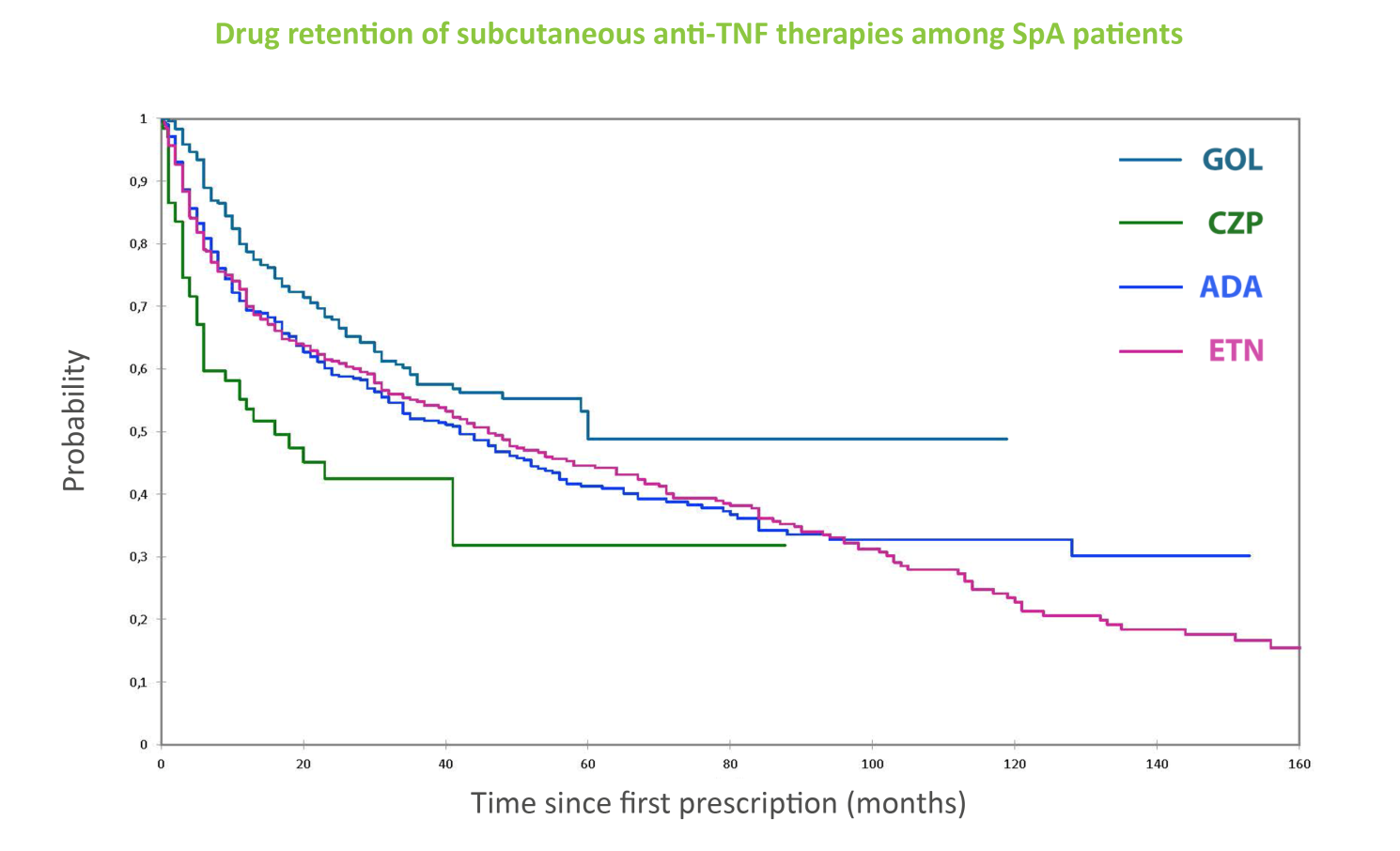
 |
|
Real Life 12 Year Retention Rate of Subcutaneous Anti-TNF in Spondyloarthritis. Results from a Multicenter Cohort of 1170 Patients
By Dr. Andus Ng
Spondyloarthritis (SpA) patients starting golimumab (GOL) have the best drug retention compared to those starting adalimumab (ADA), etanercept (ETN) and certolizumab (CTZ), according to the results of a real-world study presented by Baudens and co-workers at the 2019 American College of Rheumatology (ACR) / The Association of Rheumatology Professionals (ARP) Annual Meeting held in Atlanta, Georgia. |
 |
 This was a multicenter, retrospective, longitudinal and observational study that included all SpA patients prescribed anti-tumor necrosis factor (anti-TNF) therapies from 2004 onwards in France. The study was divided into two parts. In the first part of the study, the researchers examined the long-term drug retention of GOL, ADA, ETN and CTZ in a total of 1,170 patients. In the second part of the study, the researchers analyzed records of 425 SpA patients that were prescribed the four anti-TNF therapies from January 2013 to March 2018. The rates of drug retention at 6 months, and 1, 2, 3 and 5 years for the first, second and third courses of each anti-TNF therapy was determined. This was a multicenter, retrospective, longitudinal and observational study that included all SpA patients prescribed anti-tumor necrosis factor (anti-TNF) therapies from 2004 onwards in France. The study was divided into two parts. In the first part of the study, the researchers examined the long-term drug retention of GOL, ADA, ETN and CTZ in a total of 1,170 patients. In the second part of the study, the researchers analyzed records of 425 SpA patients that were prescribed the four anti-TNF therapies from January 2013 to March 2018. The rates of drug retention at 6 months, and 1, 2, 3 and 5 years for the first, second and third courses of each anti-TNF therapy was determined. |
 |
|
Drug retention time
In 1,170 SpA patients, GOL had the longest drug retention time among the four TNF inhibitors, with mean drug survival time of 60 weeks, whereas CTZ had the shortest, with mean drug survival time of only 16 weeks. The mean drug survival time of ADA and ETN was 42 and 46 months respectively. Drug retention rates As reported by the researchers who had analyzed the records of 425 SpA patients, the 1-year drug survival rates for GOL, ADA, ETA and CTZ were 83%, 70%, 58% and 85% respectively in the first course of anti-TNF therapy. With the second course of anti-TNF therapy, the drug survival rates at one year were 66%, 58%, 62% and 57% respectively, while with the third course, they were 86%, 67%, 76% and 51% respectively. |
 |
 |
|
In this retrospective study, GOL had the best drug retention with regard to drug retention time and drug retention rates regardless of the line of treatment compared to ETN, ADA and CTZ in the real-world setting. The researchers also suggested that investigating the factors contributing to drug retention might help explain the findings.
|

The above content is brought to you by the industry.
|
|
You are receiving this email because your contact is in the database of V·Pulse subscribers. The content and web links contained in this email may be promotional in nature. Do not reply to this email. If you have a question, please email v.pulse@vital-base.com We respect your right to privacy.
To ensure delivery to your inbox (not junk or bulk folders), please add v.pulse@vital-base.com to your address book. CONFIDENTIALITY NOTICE: This email message (including all attachments) is for the sole use of the intended recipient(s) and may contain confidential information. Any unauthorized review, use, disclosure, copying or distribution is strictly prohibited. If you are not the intended recipient, please contact the sender by reply email and destroy all copies of the original messages © 2020 Vital Base International Limited. All Rights Reserved. |





